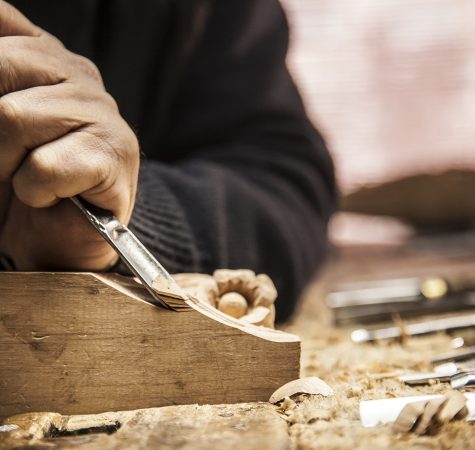by Terry Stokesbary • March 2017
Five characteristics of people who excel in their calling.
“And then he begins to tell the story.”
These are the final words of Daniel James Brown’s 2014 book, The Boys in the Boat, the dramatic tale of the University of Washington rowing team that became Olympic champions in 1936. The final words underscore the fact that the boys’ journey is a tale worth telling—and retelling.
The Boys in the Boat is a story of people honing their craft. Merriam-Webster.com defines “craft” as “an occupation or trade requiring manual dexterity or artistic skill,” but the word has broadened beyond this lexical definition. It is now used to refer to any activity done extremely well. I’ve observed that craftspeople of all kinds possess five characteristics.
Craftspeople are committed to excellence. Excellence is a hallmark of the craftsperson. Without it, what you have done is not craft. George Yeomans Pocock, who constructed the University of Washington’s boats, demonstrated excellence. In The Boys in the Boat, Brown writes, “A large part of Pocock’s genius as a boatbuilder was that he managed to excel both as a maker of machines and as an artist.” Pocock’s unusual devotion to the art of boatmaking brought him international acclaim. He inspired a generation of oarsman and was eventually inducted into the US Rowing Hall of Fame. A commitment to craft does not guarantee fame or fortune, but it often attracts recognition and opens doors to do and be more.
Craftspeople possess a deep love for what they do. Not only do craftspeople demonstrate excellence in their chosen field, they also love it. They don’t see what they do merely as a job; they regard it as a vocation, a calling. Educator and author Parker Palmer defined vocation as a mysterious, inner compulsion: “Vocation at its deepest level is, ‘This is something I can’t not do, for reasons I’m unable to explain to anyone else and don’t fully understand myself but that are nonetheless compelling.’” Vocation is a force that compels us. Our vocations are those things we would do even if we received no financial benefit from doing them. We simply couldn’t imagine life without them.
Craftspeople understand the importance of technique. Technique refers to the nuts and bolts part of craft. To build houses, you must possess knowledge of architecture, foundations, framing, plumbing, electrical systems, and much more. To shape human lives, you must understand the workings of head and heart and much more. To be a craftsperson, you must know the technique of your craft. To design boats, George Pocock needed an understanding of aerodynamics, the properties of wood, and how seats and oars are affected by the bodies that use them. Passion is not enough. Without a deep understanding of technique, excellence cannot be achieved.
Craftspeople see things no one else can see. Michelangelo once said, “In every block of marble I see a statue as plain as though it stood before me, shaped and perfect in attitude and action. I have only to hew away the rough walls that imprison the lovely apparition to reveal it to the other eyes as mine see it.” Craftspeople have vision. They see potential: the finished sculpture Michelangelo saw in the marble, the eight-oared racing shells Pocock saw in trees. Craftspeople see these opportunities and know how to use them to produce something wonderful.
Craftspeople can connect the dots of cause and effect. To know your craft is to understand how one action leads to another, to appreciate the domino effect certain actions have. Skilled chess players predict what will happen not only on this turn, but many turns ahead. Unless one can look ahead and envision what is likely to happen, one will never be great at chess. The same holds true in other endeavors. Craftspeople have a knack for understanding how their actions affect outcomes, not only today, but well into the future.
Connecting Craft and Leadership
The craftspeople of The Boys in the Boat are not necessarily the obvious ones. It would be easy to overlook Pocock, a boatbuilder, or the boys in the boat who became world champions. Al Ulbrickson, the rowing coach, and Pocock (as a person who recognized the potential in each rower) are also craftspeople. They practiced the craft of leadership. Leaders who demonstrate excellence in their leadership are every bit the craftspeople artists and athletes are.
Who are the craftspeople in your organization? Who are the ones who lead with excellence, love guiding others, understand the techniques of leading, see what others don’t, and are able to connect the dots of cause and effect? Even more important, who are the leaders of the next generation? Who is developing your future craftspeople? Who understands the strategies and programs your organization needs to pursue to change the lives of those you serve?
The good news is that craftspeople are made, not born. We speak of people honing their craft because craft requires patience, persistence and practice. One can learn to be a leader/craftsperson, but one must be taught. It is up to those of us in senior positions of leadership to train the next generation of leaders, and ensure the health and growth of our organizations beyond our tenures. Do you make time to nurture the next generation of leaders in your organization?
Honing a craft is often a lifelong endeavor, and craftspeople are usually the first to say they have room for improvement. As we steward our organizations in years to come, let’s not forget the most important craftspeople—not us, but those who follow us and practice the most vital craft for an organization’s health and vitality: leadership.
Terry Stokesbary is Senior Program Director at the M.J. Murdock Charitable Trust.
Watch this video related to craft and leadership.








